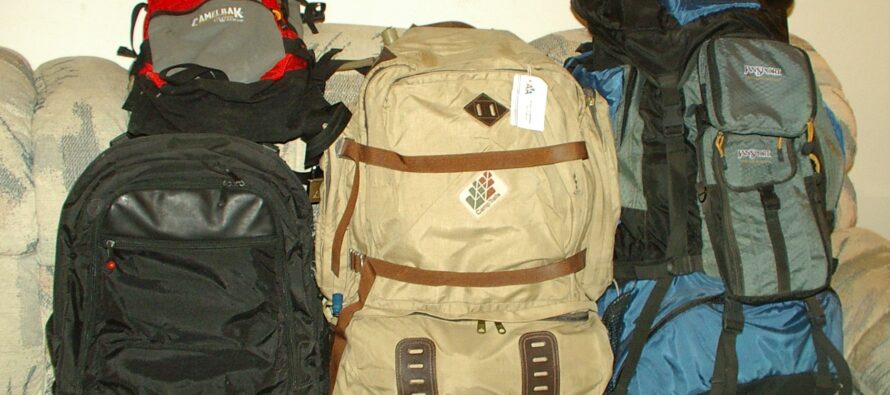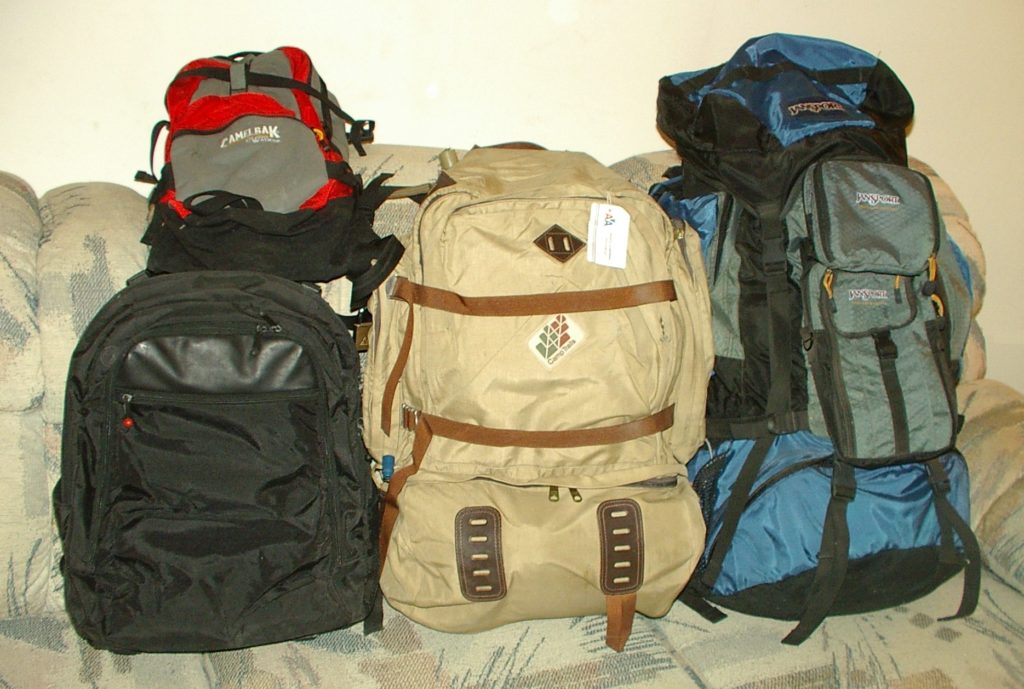Introduction to Backpacks and Bug Out Bags

Introduction to Backpacks and Using Them As Bug Out Bags
How to carry stuff has been a concern of man throughout his entire existence. You can carry some stuff in your hands, but not much, and then you can’t use your hands for anything else. Thus there has been considerable innovation in carrying technology, from pockets to specialized vehicles. When you get right down to it, for carrying a lot of stuff in the most effective manner, while on foot, the venerable backpack is hard to beat.
I have had a long relationship with backpacks; it sort of seems like I “invented” the use of backpacks as book bags at school. Having trouble keeping my school books and stuff together, and with camping/hiking experience, I went for the obvious solution of using a backpack for my school supplies. This led to considerable teasing… Nowadays, no self-respecting kid would go to school without the latest fashion in backpacks.
The backpack concept is quite broad. Some people may consider a sling bag as a backpack; it’s a pack, which often rides somewhere on your back, after all. My definition of a backpack is limited to a pack which has TWO equal shoulder straps and rides in the center of the back. This is still a wide range of possibilities, from a draw string bag with long string loops, to huge hi-tech packs for extended journeys. It includes packs with no frame, an internal frame or an external frame, and packs for a casual afternoon, a day hike (called a “day pack”), a three day trip (called a “72 hour pack”) and extended expeditions. There are specialized backpacks for various activities and functions, and general purpose backpacks. And they come in all kinds of sizes and colors and patterns, for a wide range of prices. In general, you want one which is the correct size and layout for your intended use. However, in many cases a backpack which is “too big” can be cinched down to handle a smaller load. It may not be optimal, but it does provide for more versatility. The opposite direction is less friendly but not always impossible; many packs have external attachment points to which additional or oversized articles can be attached. This is far from ideal, but again does provide for increased versatility.
I’ve had several packs in my day, many from military surplus sources, and probably still have most of them somewhere. Generally I use a small pack with a hydration bladder built-in for casual day use, a specialized laptop pack when I need to schlep around a laptop, an old internal frame pack as a “carry on” when traveling by air or train, and a fancy trekking backpack for longer outdoors excursions. I was surprised I didn’t have a “3 day” pack readily available; I’m sure I have at least one somewhere, but apparently I’ve not needed it for many years.
Despite my plethora of backpacks, lately I’ve turned my attention to the concept of a “Bug out Bag“, also called a BOB.
B.O.B. Characteristics
“Bugging Out” is military slang for quickly leaving where you are for somewhere else, often because your current location is about to be overrun by the enemy. For civilians, this usually involves a natural disaster or breakdown in society which makes the current location unlivable or unacceptably dangerous. It may seem like the thing to do given the circumstances, or you might be forced to do so by armed officials. It will almost certainly be a time of chaos, and this environment encourages some people to revert to animalistic behavior. That is, they will want to take your stuff, for their own survival or just for fun or profit.
Therefore, a key characteristic for a backpack intended to be used as a BOB is that it be unobtrusive. Look into the “gray man persona”; this is a mode of living which greatly increases your chances of surviving social chaos. That brightly colored backpack which is great for showing your style and even keeping you safely visible in the woods, is a beacon to the two legged predator, and makes it hard to hide when necessary. Having a cool “tactical” or “military style” backpack can be quite satisfying, and some of them are very functional. Unfortunately, such a pack tends to shout “Hey, good stuff over here”. What you want is a pack which helps you “blend in”. Best are dull colors, no fancy patterns, no military or tactical indications (thus no Molle system or camouflage), and frankly, one which appears to be “distressed” (dirty, maybe some duct tape “patches”, etc.). Most packs have external attachment points for stuff which won’t fit inside, but try to avoid having anything “desirable” readily visible outside the pack. Of course, avoid external attachments which are likely to make noise.
Other key characteristics are the related aspects of size and weight. The pack should be big enough to carry everything you need and light enough to not significantly slow you down or wear you out. Remember, the whole point of this pack is that you are leaving where your stuff is, and going, perhaps by foot, somewhere “better”. You may or may not have stuff there, and you may or may not have stuff “cached” along the way. And even if you do have the expectations of re-supply, circumstances may make some or all of this stuff unavailable to you.
Obviously, a pack for this purpose should be heavy duty (durable), and at least somewhat water resistant. It needs to be adjustable to your body, and comfortable to use for extended periods. Since every person’s body is different, this means optimally a pack which not only has variable length straps, but allows adjustment of the height attachment of the top point of the straps.
Some of the equipment in the pack you may need to access very quickly, so it would be good if the pack provides some organization capabilities (pockets, dividers, item loops, and/or removable sub-packs). You may be traveling through unfamiliar and varied terrain, so you don’t want a pack which will catch on things. Thus avoid packs which stick up above your head, or out beyond the sides of your body or have protrusions or sharp corners. And you want the pack to remain as close to your back as possible so it does not affect your balance.
Sizing your BOB
Unfortunately, lots of stuff and light weight are rather contradictory. Having more stuff increases your chances of survival and somewhat compensates for any lack of survival skills. However, the more stuff you have, the more it weighs, and the more weight you carry, the harder it is to move quickly and silently, the more difficult it is to hide or be unobtrusive, the more chance there is you will suffer injury, and the more energy you expend for any movement. For each person, there is a balance point, where you have “enough stuff” without being “over-loaded”. It is “conventional wisdom” that maximum pack weight is 25% of your body weight, but this is not really practical. Sure, if you weight 200 pounds, than you can probably put on a 50 pound pack and even walk with it for a while. But can you walk with it, all day, every day, for a week? Can you climb hills with it? There is a competing viewpoint that a 25 pound bag would be more practical.
The problem is that backpacks are not rated by weight, and cannot be, since their weight is largely dependent on what you put in them. Backpacks these days are often rated for size in “liters”. That is, a backpack may be described as being “40L”. That means its physical capacity is 40 liters, or about 10 gallons. Now 10 gallons of water weighs 80 pounds, while 10 gallons of foam (often used in stores to show off the shape of the pack loaded) weighs very little. In order to get a load you can effectively carry, your choices are between less stuff and lighter stuff (which tends to either be flimsy or much more expensive).
It appears the practical size for a BOB is around 60L to 65L. Much bigger and you would not be able to fill it without raising the weight to an untenable level. In my opinion, you don’t want to go much smaller unless your circumstances force this on you.
In any case, whatever weight pack you end up with, you can’t just expect to be able to grab it and go. Start out with that empty pack (filled with foam) and walk with it, slowly increasing the weight until you are in shape for your actual weight. Oh, and even when you reach that stage, keep on training so you don’t lose your conditioning. It would suck on so many levels to leave a trail of discarded gear behind you. As an aside, you may have trained yourself to the point where you can carry all your gear for an extended period of time. But can you use each and every piece effectively? If not, learn and practice.
Frame Choices
A pack with no frame is not for serious use. All the weight is applied to the strap attachment points, and there is little structure to the bag. The original frame concept was an external frame to which a “soft” pack was attached. This was really good for carrying a load, but it was a little uncomfortable and unstable, could get caught on things, and just did not have a good appearance. Internal frames packs were developed and are the optimal choice these days.
Some packs have only the shoulder straps. These are also not for serious work. They are fine for an afternoon, but you want to take some of the weight off of your shoulders for long term use. This means that you need a padded waist belt as well.
Pricing
It appears backpack prices have gone up considerably since the last time I bought one. Name brand ones I looked at tended to be $200 or more. This may be tolerable for something which is used a lot, but for something which will be stuck in a closet or car trunk except for training walks, that’s a bit much. I turned to my friends at GearBest who offer a few packs in my target 60L to 65L size range, with appropriate colors and best of all, prices under $50.
Editor’s Favorite Survival Packs
Tune in next time for a review of what appears to be GearBest’s best option.
Visit: EZ Battery Reconditioning To Learn More here: http://www.survivalistdaily.com/ezbatteryreconditioning







